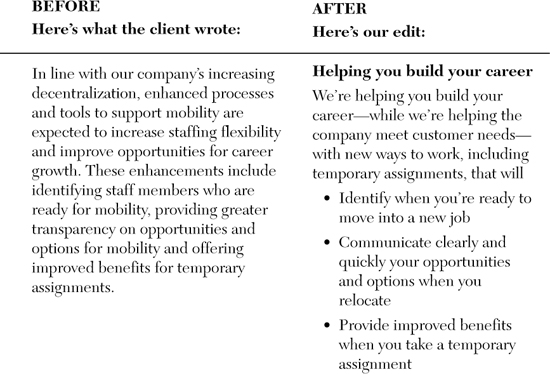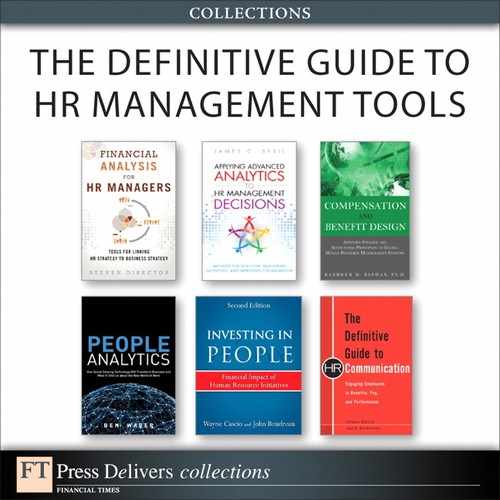Introduction
Effective HR Communication: How to Get Employees to Pay Attention, Understand What’s Changing, and Take Action
Your company makes a big investment in designing benefits, pay, and policies to attract and retain the best employees. That’s why it’s so frustrating when employees don’t understand their benefits—or worse, don’t appreciate what’s available to them.
Employee confusion about key HR issues is all too common. In fact, most employees report that they are dissatisfied with communication about benefits and programs. For example, a 2007 Prudential study1 found that only 35% of employees rate benefits communication as “highly effective.”
And there’s a direct correlation between how well employees understand their benefits, pay, and policies and how much they value and use their benefits. So poor communication leads to low usage, and low usage leads to poor perception. For example, only 44% of employees in a 2009 MetLife study2 reported being satisfied with their benefits.
This is obviously a problem. First, workers who aren’t knowledgeable can’t make smart decisions or take appropriate action. Second, the less they know about pay and benefits, the less satisfied they are. The MetLife study discovered that 70% of employees who have a strong understanding are happy with those benefits, but when understanding is low, only 7% are satisfied.
What causes employee confusion? A big factor is poor communication. Most HR departments generate a steady flow of communication, but employees don’t find it effective. In fact, only 33% of employees in the MetLife study strongly believed that current communications educated them effectively. What’s even more surprising is that only 36% of employers think communication effectively educates workers.
“Help!” Cry HR Managers
HR managers know that communication is a big challenge. We’ve spent the past couple of years traveling around the country, talking with HR managers about communication issues. Here’s what they tell us:
• “We have so much information to get out to employees regarding benefits and other HR-related services. We use e-mail, desk drop, posters, an intranet site, and mailings to homes. People don’t have time to read it! Then they call with big issues.”
• “My biggest challenge is reaching employees who work out of town; they don’t receive their mail for long periods of time and don’t use computers.”
• “I struggle to boil things down to a level everyone can understand.”
• “It’s so difficult to get the message across to people who won’t read it. It’s about benefits and they complain that it’s too complicated. ‘Just tell me what to do,’ they say.”
• “I want to engage more employees in learning more about their benefits and attending annual open enrollment sessions. How do I increase participation in info sessions?”
• “How can I provide benefit information or instructions to a group of employees who vary widely in their level of understanding?”
• “It’s hard getting people to understand, not just listen—to get and keep their interest.”
• “I find that employees don’t read the materials. The information is too technical.”
• “I find myself answering the same benefit questions over and over. Aargh!”
Why Don’t Employees Pay Attention?
In a way, confusion about HR programs is surprising: Since employees care deeply about these issues, you’d think they’d work hard to understand them. For example, in the MetLife study, employees say the most important factors affecting their loyalty to the company are
• Salary/wages (83% of employees agreed)
• Health benefits (75%)
• Retirement benefits (72%)
In fact, these priorities rank higher than advancement opportunities (57%) and company culture (50%).
In the past, employees would pay attention to any HR communication that came their way. Even if the communication was long, dense, and difficult to understand—for instance, a Summary Plan Description—employees would do the heavy lifting to make sense of it.
But times have changed. Benefits, pay, and retirement programs are more complex than ever before. And employees today simply don’t have the time to hack their way through a thicket of information—even when the topic matters to them. They’re quick to press the Delete key or file a message for future consideration or simply let it fall to the bottom of the pile. They wait until a deadline is looming—or until an issue is so urgent that it can’t be ignored—before they read the message.
A number of factors can cause a breakdown in communication:
• Information overload. Workers are overwhelmed. For instance, the research firm Basex3 estimates that 28%—more than one-fourth—of an average knowledge worker’s day is taken up by managing unnecessary e-mail and instant messages. Another firm, RescueTime, calculates that a worker who sits at a computer all day turns to his e-mail program more than 50 times and uses instant messaging 77 times.
• Complexity. HR information used to be simple. There was one healthcare plan, one company-paid retirement program, and a few job-related policies. But today choices abound. Complexity is the order of the day. It’s no wonder that 55% of U.S. healthcare plan members don’t fully understand critical details about their insurance coverage, according to a 2008 study by J.D. Power and Associates.4
• Employee attitudes. In a business environment where layoffs occur often, it’s no surprise that employees don’t have the same sense of loyalty and connection to their companies as they used to. So they view any “corporate communication” not with enthusiasm, but with caution at best or skepticism and distrust at worst.
• HR’s reputation. In many companies, employees have had negative experiences with HR—and with HR communication. For example, in focus groups we’ve conducted, we’ve heard employees give feedback like this:
• “HR doesn’t respect my time.”
• “HR communication includes way too much jargon.”
• “HR isn’t interested in me; it’s all about pleasing senior management and cutting costs.”
• “Here comes another takeaway.”
What’s Wrong with This Picture?
Created (or at least approved) by subject-matter experts, HR communication often offers technical information in a dense and thorny presentation—a veritable maze of information. And when it’s vetted by lawyers, you’ll find caveats and disclaimers that create another barrier to understanding.
Perhaps even worse, most communication seems designed to appeal to management by using language and tone more suited to the corner office than to the cubicles where most employees work. As a result, employees tell us that too often they find communication confusing, inconvenient, irrelevant, and just plain annoying. They also say they’re unclear about what action to take and how to get their questions answered.
A Fresh Approach
It doesn’t have to be this way. We’ve discovered that communication can meet all its obligations (to lawyers, the government, and company management) while appealing to employees. From decades of experience, we’ve developed a communication approach that interests employees, persuades them of the value of a program or policy, and helps them decide on the course of action that is best for them (and their company).
Our approach is simple: treat employees as customers of HR benefits and services. We use the same strategies, tools, and care your company uses to sell your products or services to your customers. We learn all we can about employees (age, years of service, education, job family, location, salary, and more), and we learn from employees themselves how, when, where, and from whom they like to receive information. We determine the specific information that employees need and when they need it. Then we package the information for them in ways that make it easy for them to understand and make good decisions in a timely way.
Here’s an example of what we mean:

When what you write (see BEFORE) sits there like a block of gray granite, it’s hard to read, whether it’s on the screen or in print. When the language isn’t conversational—doesn’t talk directly to the reader—it’s harder to figure out “what it means to me” as the reader. Effective HR communication, on the other hand, makes information accessible, easy to understand, and useful.
As a result, employees know what they can expect from the company, and they know what the company expects of them.
When you create effective HR communication, you
• Help employees take advantage of all the benefits and programs the company offers
• Make it easy for employees to understand and use benefits and programs effectively
• Answer most of the questions employees have about company benefits, programs, and policies
How This Book Can Help
This book shows you how to communicate differently and more effectively. Even if you’re already doing a great job, we can help you improve.
First, we provide practical tips on how to take communication from boring to compelling. Then we give you advice on how to communicate in these common situations:
• Recruiting
• Orientation
• Policies
• Benefits
• Compensation
• Performance Management
• Saving for Retirement
• Leaving the Company
Along the way, we do the following:
• Supply evidence that will impress senior managers and convince them that you need to change your approach to engage employees successfully.
• Provide an approach that you can use every time you craft a brochure, web page, electronic newsletter, or even a brief e-mail.
• Give specific techniques for how to communicate in a more accessible way, including breaking your points into digestible chunks; signaling what is ahead in your text (with packaging devices such as subheads); and giving your audience all kinds of other tools—such as charts, checklists, and captions—that allow skimming and scanning.
• Show examples of good communication (and explain why it works) and bad (and offer advice on how to make it much better).
• Practice what we preach by demonstrating our strategies and techniques throughout the book.
We also bring in examples from real companies to make the business case that demonstrates how to communicate more effectively. As a result, you’ll learn how to
• Communicate faster, more efficiently, and more effectively.
• Help employees take advantage of all the benefits the company offers.
• Make it easy for employees to understand and use benefits effectively.
• Answer most of the questions employees have.
Doing It Right Means a Better Bottom Line
What’s in it for your company if you read this book and follow the advice presented here?
The bottom line is simply this: Good HR communication helps contribute to employee productivity, which in turn boosts your company’s profitability. There’s a good reason to turn the page.
